Introduction
Revenue is the lifeblood of any successful business.
If you aren’t making sales and converting customers, your business won’t survive.
Most people turn to PPC to promote their products, but typical conversion rates are less than 3%.
And many also turn to Facebook Ads, but 62% find that they don’t work or often miss their target audience.
But you need to develop new streams of revenue if you want your business to survive.
You can’t risk depending on your word of mouth or referrals for reliable business.
Since you likely already spend hours on social media every week (whether you like to admit it or not), why not turn that into a monetized revenue stream?
You can leverage the power of Facebook Groups to drive huge traffic, fans and ultimately: revenue.
And that’s exactly what Karen Kawallek of Lake Providence Lodge did.
She turned a typical hobby into something that drove revenue like she’d never thought possible.
And Facebook is the perfect platform to do it.
There are over 2 billion monthly users on Facebook, and that number keeps growing every single day.
Meaning there are countless ways to hook in customers and generate revenue without spending hours tinkering with PPC ads or spending thousands on an SEO consultant.
Karen sells her scented wax melts on Facebook to her finely-tuned Facebook Groups and uses them to leverage fast growth.
Here we’ll explain what Facebook Groups are, how Karen grew her following and drove sales, and how you can do it, too.
Facebook Group recap:
Simply put, a Facebook Group is a place where people can join communities of common interests.
For example, you could create a group for almost anything. If you and a bunch of people love pizza, you can create a pizza lovers group.
The whole point of groups is to bring like-minded people together for discussion, opinion and sharing content around that subject together.
To give you an example, here’s what the Providence Lodge group looks like:
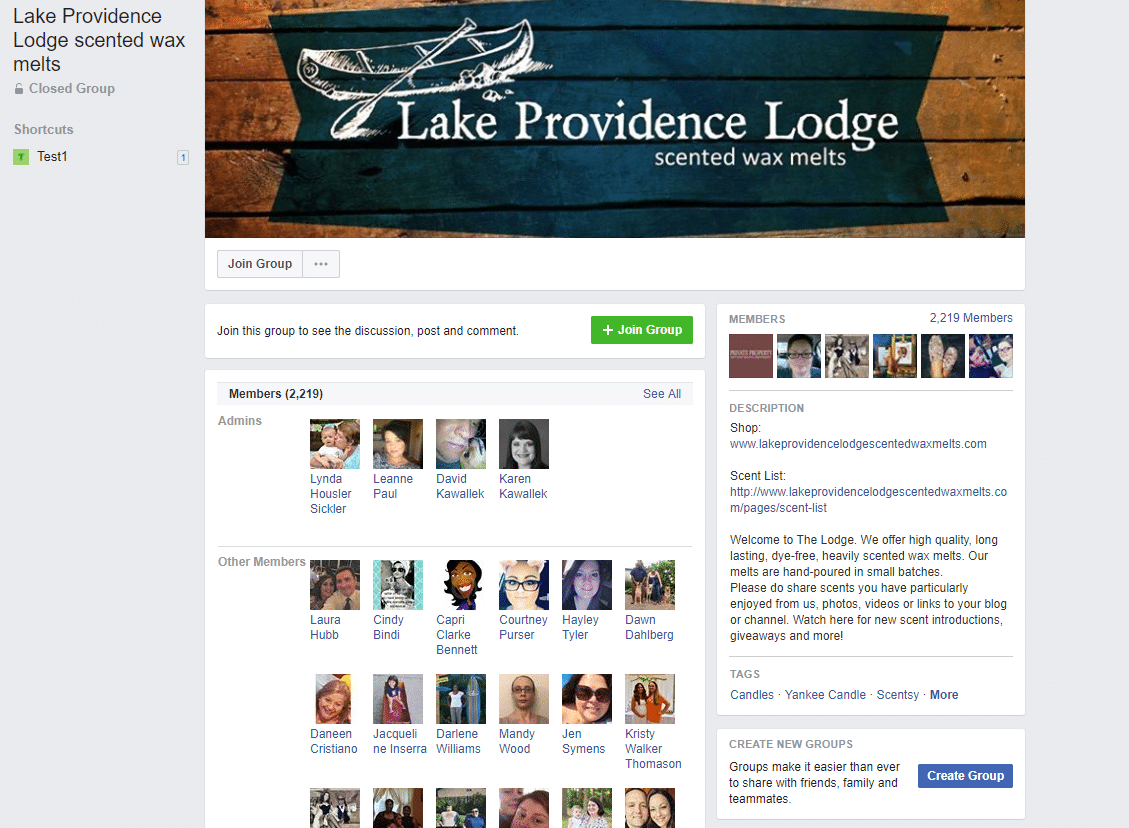
It’s a community of people who loved their scented wax melt products.
So, how does it differ from a typical Facebook Page?
It’s more organic and personalized than a typical Facebook Page.
When you navigate to a company Facebook Page like Red Bull, you notice quickly that it’s not personalized.
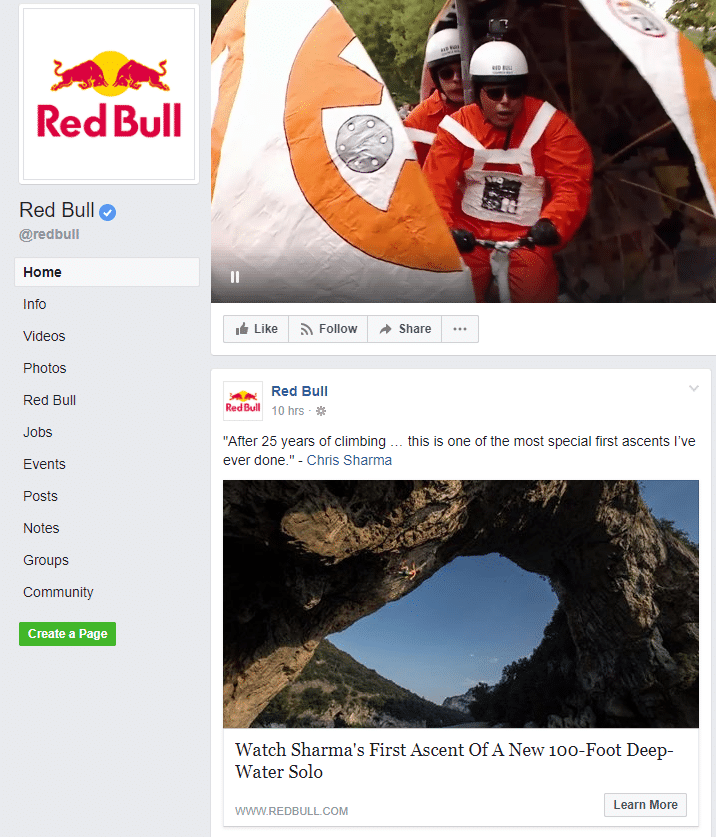


It’s a typical company page that posts updates about new content and the inner workings of the business.
But Facebook Groups allow your fans to actually engage with personalized discussion.
On a company page, you can’t interact like a real person. When you respond to comments, it’s just the brand.
But, on a Facebook Group, you can do the exact opposite. You can actually communicate from your personal account:
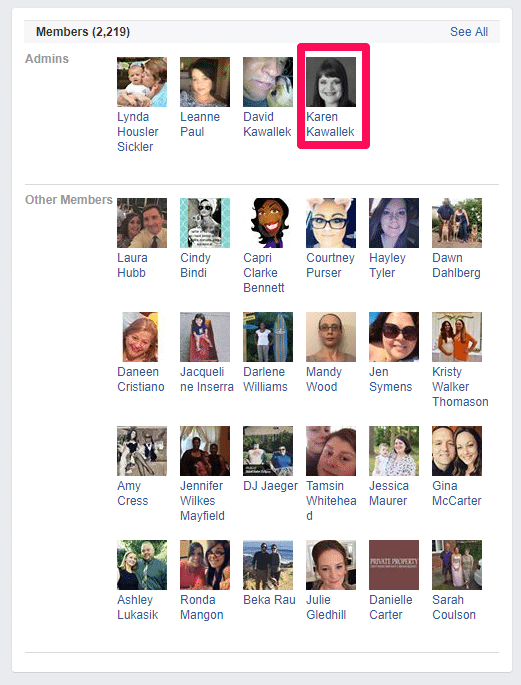


Meaning that your personal engagements with real people will be long-lasting.
Instead of engaging from behind a corporate logo, you can talk to people with your real account.
Group members can participate and have their voices heard.
They can share information on the product, reviews, and start discussions on their favorite products.
Groups give you the ability to craft a close-knit community around your brand and product that wants to keep engaging with you.
Rather than boosting Facebook Page posts and hoping for organic engagement, you’re generating it daily on the group without effort.
And Lake Providence Lodge was able to leverage their 2,000+ member group to generate revenue for their business.
Here’s how they did it.
How Lake Providence Lodge Did it
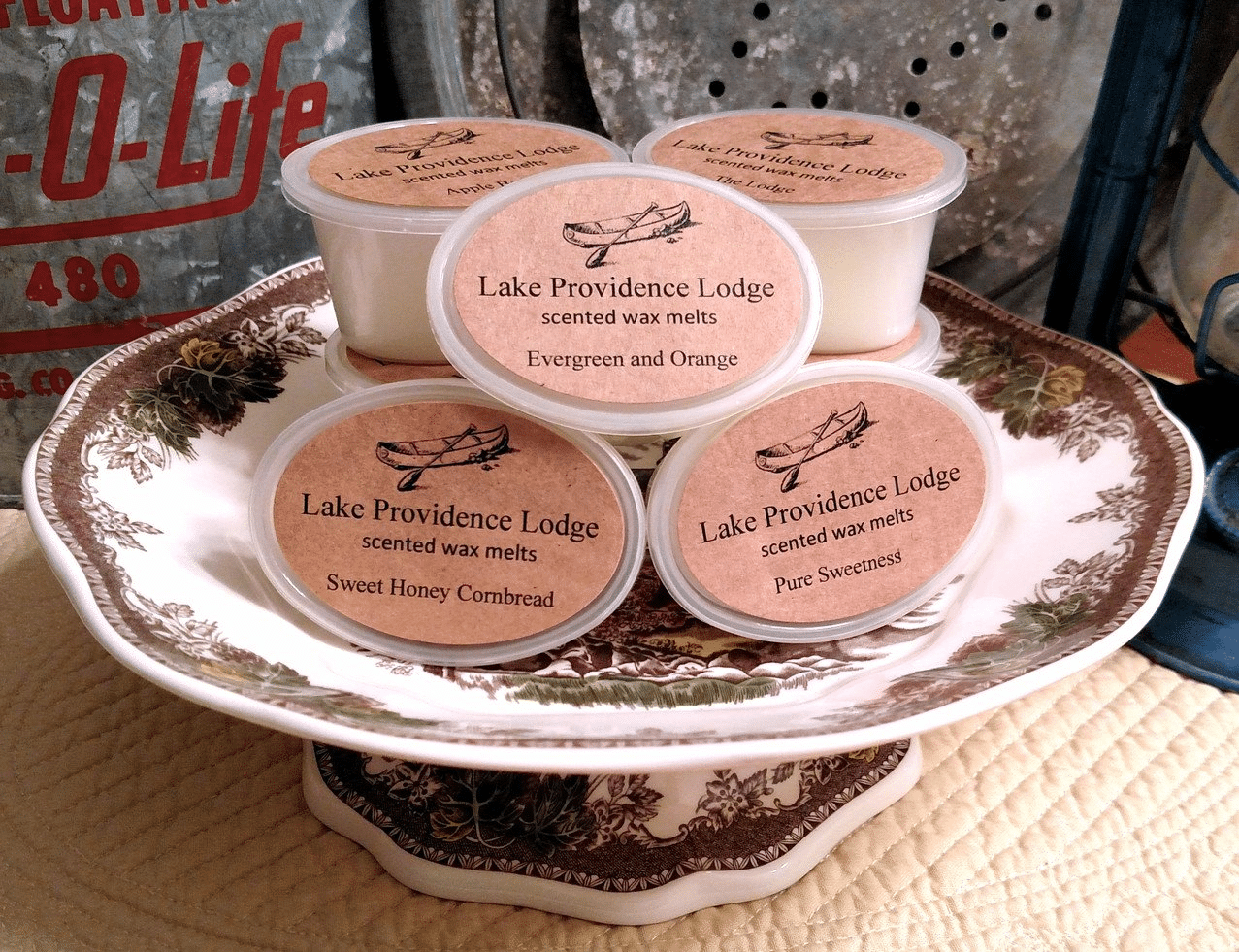


Karen Kawallek of Lake Providence Lodge wasn’t always an entrepreneur.
In fact, she says she still works for the same corporation she worked for when she came out of college.
She’s been there for over 29 years and decided to start a side-business in 2012 to explore her hobbies and bring in more money.
That may come as a shock to most entrepreneurs. Most people assume that starting a side-business while working a 9-5 is impossible.
But when you create new revenue streams that work for themselves, it isn’t.
You don’t need to spend every hour tweaking PPC campaigns and developing content to succeed.
In fact, without any coding experience whatsoever, Karen opened up her wax melts shop on Shopify.
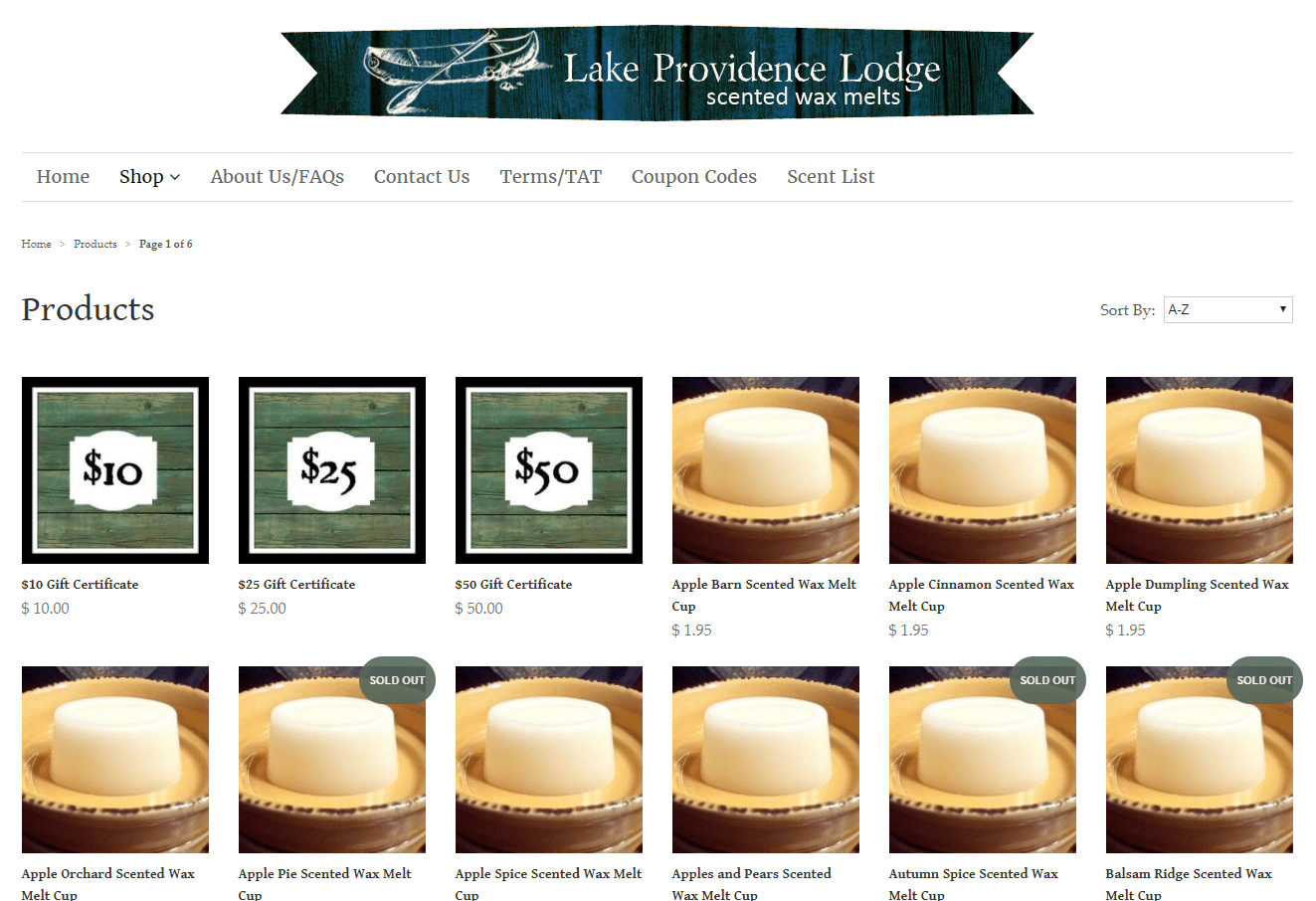


She found a niche market that wasn’t fulfilling her own needs.
She loved candles and wax melts but was never really satisfied with the quality and craftsmanship of big brand options.
But, being a niche market in the larger candle sector, she faced an uphill battle.
It’s almost impossible to compete in the ever-growing candle industry when giants like Yankee Candle own the majority of the market share.
So, she started on Etsy. She found immediate success, but the costs that she was forced to pay to Etsy were too high.
She began selling at local craft fairs and farmer’s markets and found great success there, as well.
But she found that it wasn’t as easily scalable and that digital was the way to go.
She quickly developed her Facebook Group to target hyper-specific individuals who were buying her products consistently.
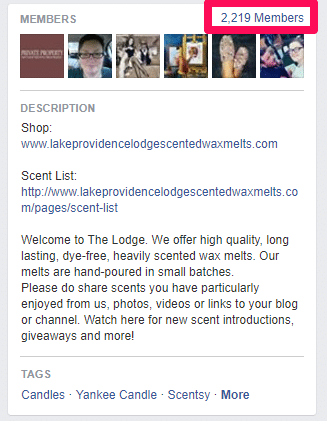


She followed the “1,000 True Fans” method of building a list of customers that had higher lifetime values.
This allowed her to tap into that revenue stream with ease, providing tons of sales with basic engagement.
And today her part-time business is doing over $3,000 in sales each month.
On top of that, her conversion rates are way above average:
- 20-23% of visitors will add something to their cart
- 15% will initiate check out
- 12% will purchase
She’s barely putting in any marketing time due to her full-time job, yet is still able to drive tons of revenue using her Facebook Group to spread the word and generate hype.
Why? She says her audience is a highly-engaged group that she interacts with personally on a daily basis!
She’s literally taking the time out of her day to personally message and respond to her group every day.
And that kind of dedication and personalization drives sales.
Ready to grow your business with Facebook Groups? Here’s how.
Here’s how you can do it too
One of the biggest elements that Karen stresses is her Facebook Group and the importance of building that organic communication and discussion to drive sales.
She said that the two-way communication beats boring advertising any day, and that actually establishing relationships with the people who buy your product can skyrocket their customer lifetime values.
Meaning that instead of wasting time on PPC to drive a few sales here and there, she focused on building her Facebook Group with great customers.
Thankfully for us, Karen’s process is replicable and easy to implement.
Here’s how.
Step 1. Create your Facebook Group and optimize it
The first step in generating revenue with Facebook Groups is to create one!
This process is relatively easy and should only take you a few minutes to do.
Remember: Groups are different than Pages.
To start creating your group based on your company and product, head to your Facebook account and click “Groups” on the left-hand side bar:
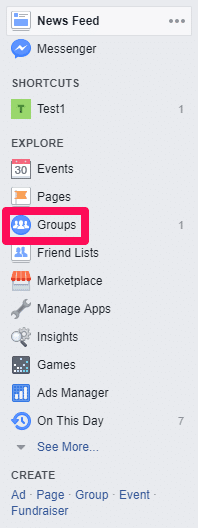


This will show you all of the groups you are currently a part of, but to create a new one simply hit “+ Create Group” at the top:



Next, you need to fill out key information for your group:
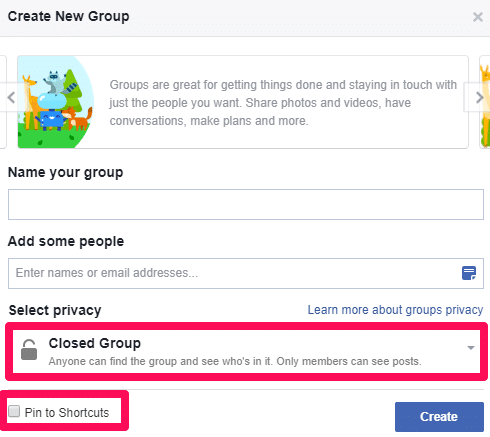


Start by naming your group just like you would name your business page.
Karen named hers “Lake Providence Lodge Scented Wax Melts” just like her domain and business page.
Keeping things consistent here is key for branding purposes.
Next, make sure to set your group privacy to “Closed Group.”
This will help you control the people that join your group.
And remember: Facebook Groups are highly specific, targeted groups of people who will buy your products consistently.
So, don’t let anyone who isn’t an enthusiast join.
Next, on your new Group page, click on the settings drop down and proceed to edit the settings of your Group:
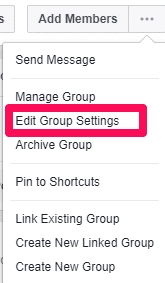


Here you can edit everything that you need to brand this Group as your company’s own:
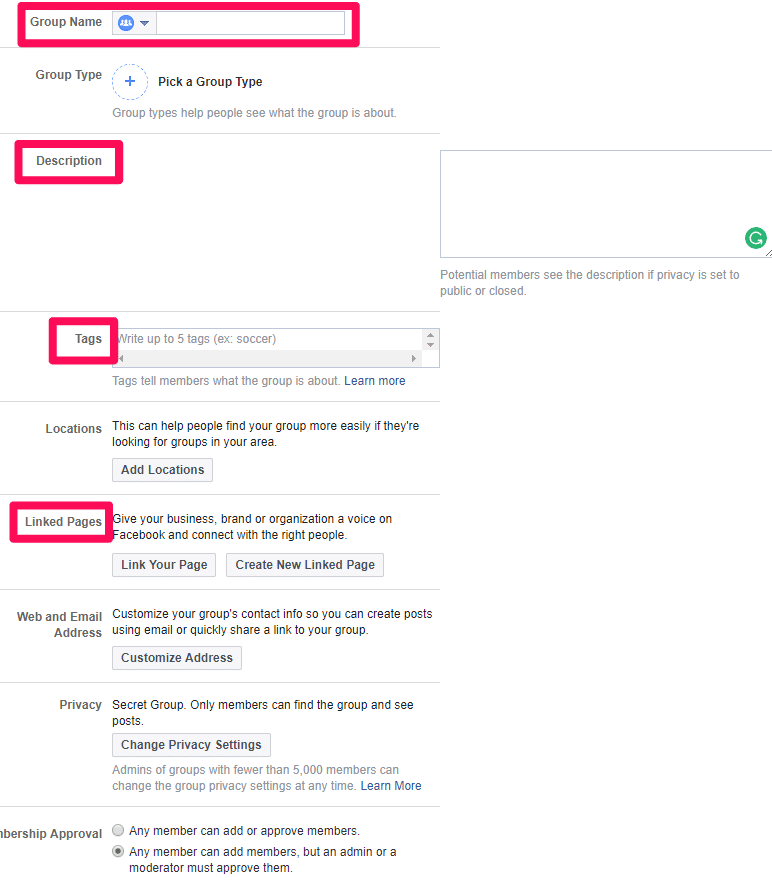


Make sure to include a brief description and tags that are popular so people can discover your Group in the future.
Here’s what Karen’s looks like:
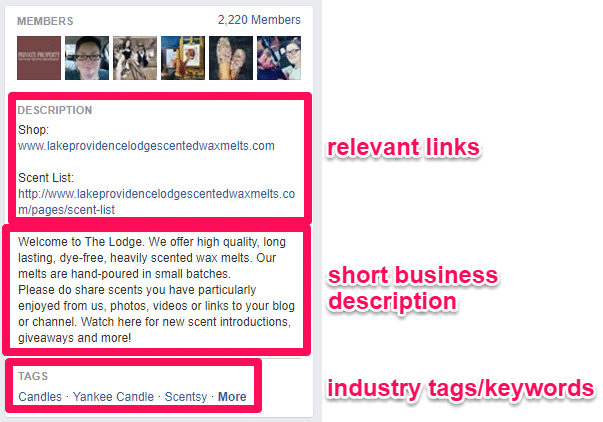


Relevant links to your business will point traffic directly to your products and your site.
Using a short business description will help explain to new visitors what they can expect.
And using industry tags and keywords will help you drive more traffic!
You should also use your company logo on the Group like Karen:
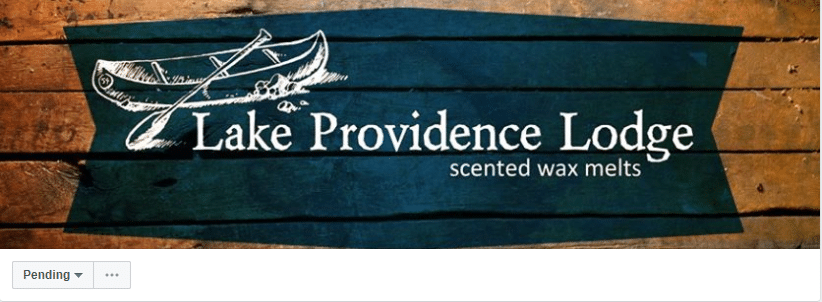


To edit the header image, head to your new Group page and hover over the cover photo to change it:



Simply upload a photo from your computer and hit save!
Ready for step 2? It’s time to research Group targets.
Step 2. Research other Groups to target prime users
Karen credits one of her biggest successes with Facebook Groups by researching other groups in her industry.
Her strategy involved searching for and joining relevant groups to her product.
For example, her product is a candle style product.
So she looked for groups that revolved around candle making or candle enthusiasts.
And look how many members these incredibly-niche groups have:
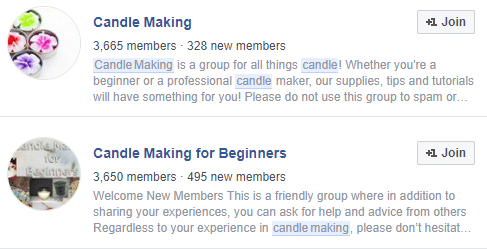


Karen says that the key here is to search for relevant groups and then actively participate in them to build trust and credibility.
You can’t just join enthusiast groups and spam your product hoping to make a quick buck.
It doesn’t work that way on Facebook Groups. You need to build trust. Be authentic and provide real value.
It’s not free advertising. Yet.
To find groups that are related to your product niche, type in general industry keywords into the Facebook search bar and select the “Groups” tab to sort the diverse search results by existing Groups:



Now you should have a filtered list of the top Groups in your industry:
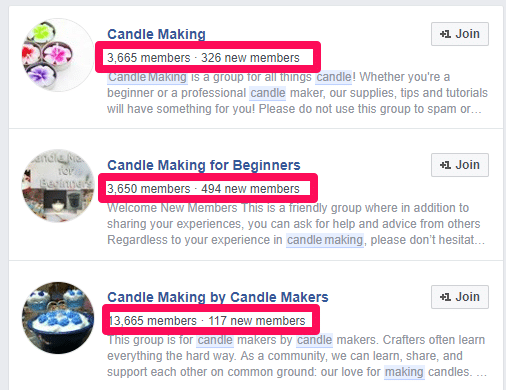


And you can even check out how active these Groups are by looking at their member totals as well as new members.
Once you’ve scouted a few groups that are active and loaded with members, you need to join them.
But, first, Karen recommends to read their Group description:
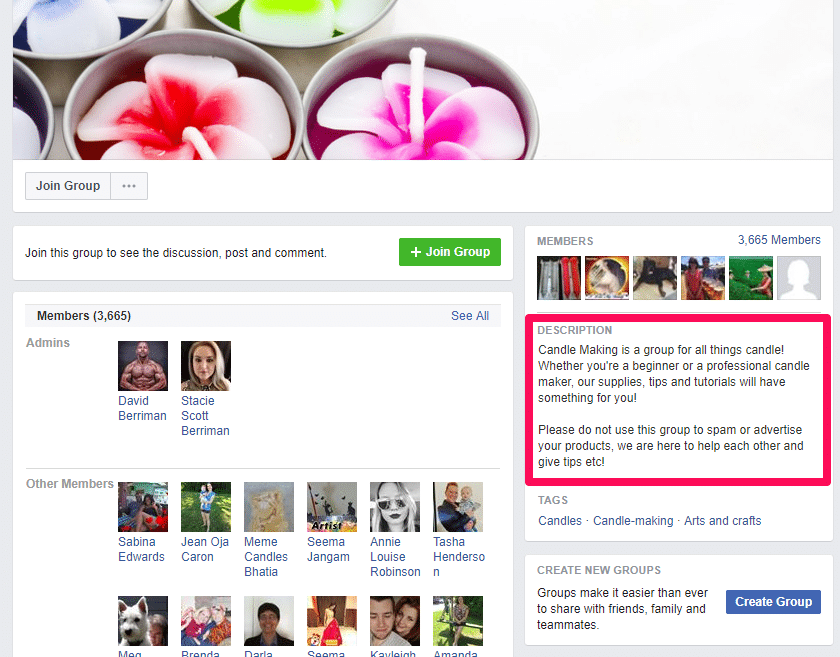


Make sure that the Group isn’t going to be filled with spam. You want high-quality Groups with passionate people, not spammers.
You might be wondering: Isn’t that counterintuitive if I want to use it to drive revenue?
Not at all (more about this in step 3).
The groups should be a place for you to interact with people and establish yourself as an expert in your niche.
Then you can start to deliver the goods.
To join the group, simply hit “+ Join Group”:



Beware, you need to be approved for most Groups, so consider sending a private message to the admins of the group:
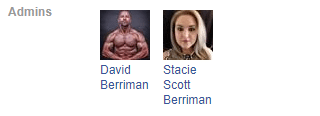


This way you can establish yourself as a trustworthy participant on the subject and even start to inquire about things like giveaways.
These groups are hyper targeted, and the admins are always on top of their game.
Meaning you need to be active.
You can’t simply join and expect to drive revenue. Interact, engage and comment on people’s posts on the group!
Once you’ve joined a few groups and established your presence, it’s time to reel these hyper targeted users into your revenue funnel.
Here’s how.
Step 3. Drive traffic to your Group with giveaways
Now that you’ve built up a trustworthy personal brand on these Groups, you need to get them back to your own Group to drive revenue.
Karen had a specific strategy for doing just that. She recommends giveaways.
She does them all the time on her Facebook Page and Group:
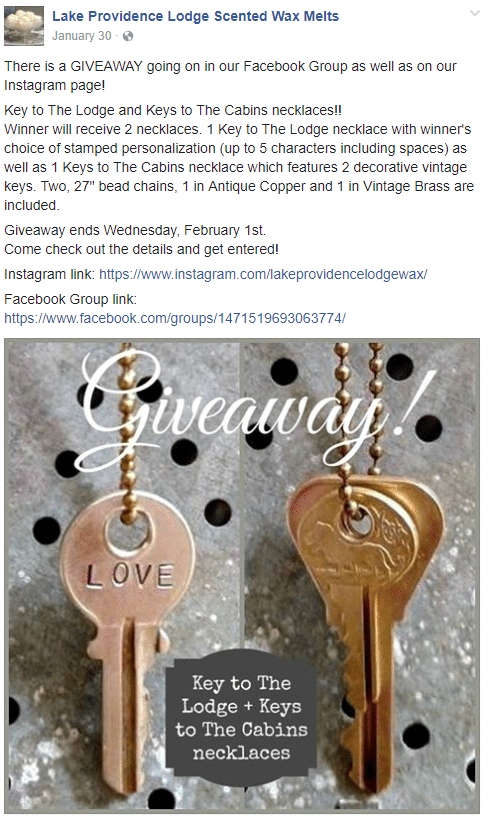


She says that she has used this strategy to drive over 2,000 people back to her own Facebook Group from those general niche groups!
Let me recap:
She researches groups that have thousands of active users in her niche, she joins and interacts, and then she offers giveaways to drive those visitors back to her own Group page.
To start making giveaways, Karen recommends you can start small with $10 giveaways to spend on your site or products that are small in value but still carry weight and interest in the group.
To get started, use a popular giveaway platform to control entries like Gleam.
Gleam is a great tool to set up giveaways with clear-cut instructions, rules, and a verifiable entry system.
First, head over to Gleam.io and click “Start Using Competitions.”



Next, login directly with your Facebook account for the easiest access:
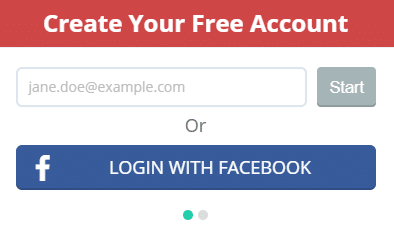


Then, you’ll be directed to your dashboard. In the top right-hand corner, click “+ New Competition”:



Now you can start to edit the details of your giveaway:
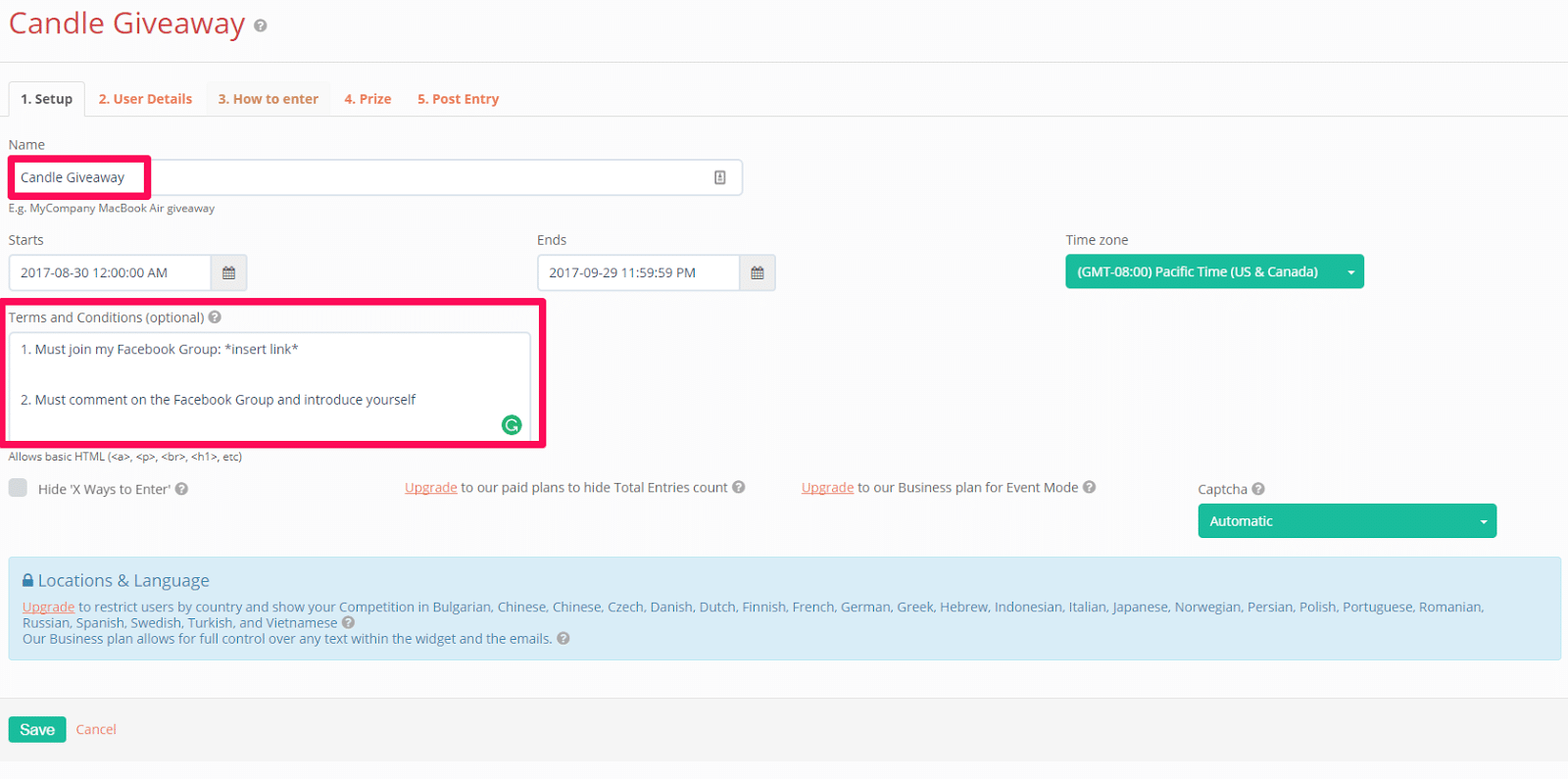


Make sure to give it a recognizable name that will appeal to users on the groups you are targeting.
Under the Terms and Conditions section make sure to state clearly what someone has to do to enter the giveaway!
Next, you can also control different ways to enter:



You can have people follow you on social media, download an app, or customize it to your liking.
You can even direct people straight to your Facebook Group to join:



And you can add an entry that drives tons of traffic to your site by choosing the custom option:



Next, customize the steps to let people know how to enter:
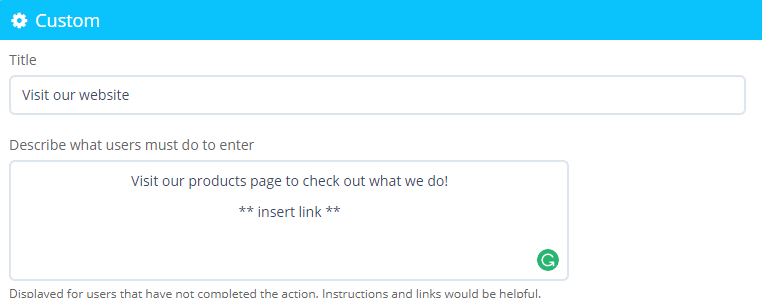


It’s that easy!
Once you’ve set up your giveaway, copy the link to it and paste it in your targeted list of Facebook Groups.
Use it as an opportunity to sincerely give back to these Groups and build loyalty.
Drive them back to your Group to build your own page, too.
Step 4. Build engagement on your own page
Once you’ve driven tons of traffic back to your Facebook Group through hard research, interaction and giveaways, you need to use that group to drive sales.
Karen recommends sparking engagement as the best way to drive traffic and more sales from your own Facebook Group.
She takes advantage of things like Polls on her Group page to start discussions.
To create a poll, head to your Facebook Group and start a new post from the page:
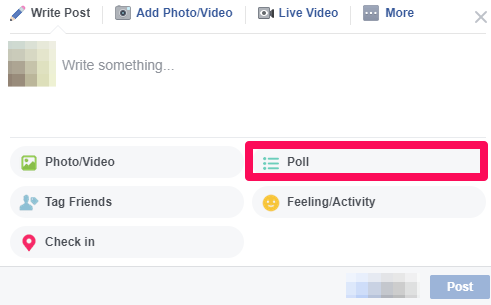


Select the Poll option to get started. Add in a simple question and minimal answers to keep people interested.
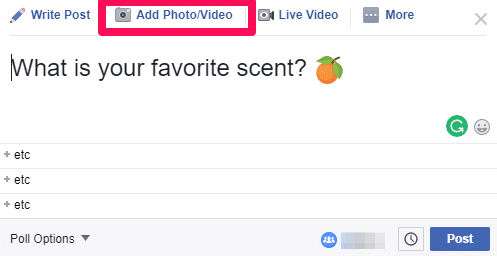


Consider adding photos and video to drive more engagement, too!
The goal of this step is to harness the power of your new Facebook Group.
Engage with people in the group. Spark discussion with Polls. Post photos and videos of “behind the scenes” content to build credibility.
If you do anything make sure you do this:
Genuinely interact with the users who are talking in your Group to make sure they have a voice and that their ideas are heard.
Use these tools to build an active Group and drive revenue on your products.
Now It’s Your Turn
Your business goals should focus on one thing only:
Revenue.
It’s what makes the machine run and keep running.
If your business isn’t generating sales, you won’t grow.
And most people use typical advertising platforms to achieve that growth.
They try Facebook Ads, PPC platforms, and SEO, only to find that they tapped out most sources with minimal benefits.
Or, they get disappointed by the abysmal average PPC conversion rates.
And most will turn to Facebook Ads only to be disappointed saying that they don’t work.
But you need to find our own niche streams of revenue that will keep producing sales for you.
You can’t risk depending on one or two streams of revenue that could die at any moment.
Just like building an email list, you should start building your Facebook Groups.
That’s exactly how Karen of Lake Providence Lodge grew her business.
Start by creating a branded Facebook Group that you can drive traffic to.
Then, research other industry related niche groups that you can join and participate in!
Start giveaways on those pages to drive those users back to your own group.
Then, talk about your products and get people interested in purchasing.
So give it a try. And drop a comment below to let me know how it goes.
Already using Facebook Groups? What free methods of social media list building have you taken advantage of? I’d love to hear them!
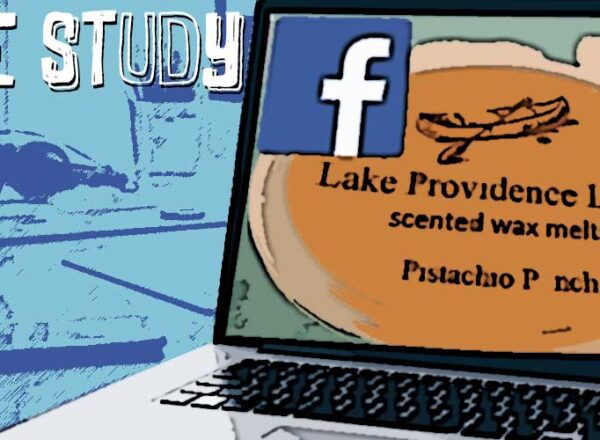
Comments